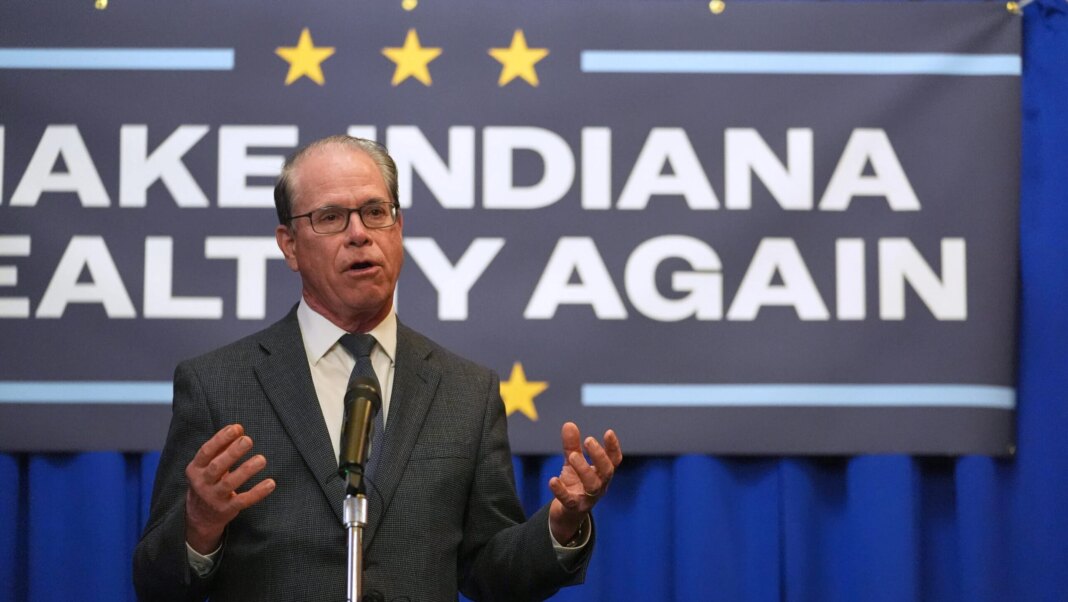Indiana’s Congressional Redistricting: A Heated Call from Governor Mike Braun
On Monday, Indiana Republican Governor Mike Braun challenged state lawmakers to reconvene in Indianapolis for a special session aimed at redrawing the state’s congressional boundaries. This move aligns Indiana with a wider national trend of midcycle redistricting, fueled by pressures within the Republican Party, particularly from former President Donald Trump.
The National Context of Redistricting
The backdrop of Braun’s call reflects a growing urgency among Republicans to gain an advantageous position in the upcoming midterms. Trump has been vocal about his desire for Republican governors across the nation to reshape congressional maps to facilitate an easier path for the party to maintain control of the House. States like Texas and Missouri have seized this opportunity and swiftly enacted new district maps. In contrast, Indiana lawmakers have treaded carefully, engaging in lengthy discussions that have produced little consensus.
Special Session Proposed for November 3
Gov. Braun advocates for the General Assembly to gather on November 3 to deliberate the proposed changes. Despite his firm stance, the support within the Republican majority Senate remains uncertain. Recent statements from Senate leadership suggest a lack of sufficient votes to pass a new congressional map, raising questions about the feasibility of the special session.
Behind Closed Doors: Meetings with Influential Figures
In the weeks leading up to this call, the White House engaged multiple times with Indiana lawmakers, attempting to gauge their willingness to shift congressional boundaries. Notably, Trump met privately with Indiana’s state House Speaker Todd Huston and Senate President Pro Tem Rodric Bray, further igniting speculation about the party’s direction in this redistricting effort.
Prominent figures, including J.D. Vance, have also been involved in discussions around this topic, meeting with Braun and state legislators to advocate for a quick resolution. Vance’s return to Indianapolis earlier this month underscored the urgency felt within party lines, but skepticism persists about the Senate’s ability to rally behind a revised map.
The Legislative Landscape: Support and Opposition
Braun’s alignment with Trump positions him as a staunch ally; however, Indiana’s political environment has traditionally leaned towards a more reserved approach. Following a controversial 2022 special session that resulted in a strict abortion ban, state lawmakers have become increasingly cautious. Some Republican legislators have voiced strong opposition to midcycle redistricting, raising concerns over costs and potential political repercussions.
Historically, Indiana’s Republican leaders have expressed satisfaction with the boundaries established four years ago. Senate President Bray emphasized that these maps reflected public feedback and would effectively represent Hoosiers for the coming decade.
The Challenges Ahead: Legal Implications and Political Dynamics
The process of redistricting usually unfolds every decade following the census. If Indiana lawmakers successfully alter the congressional maps this fall, legal challenges are anticipated from opponents who could contest the new boundaries in court. Indiana’s constitution grants the state legislature exclusive authority to draw these maps, and the Republican supermajority means that the party can push forward without requiring any Democratic participation, unlike similar efforts in states like Texas.
Assessing Potential Targets: Indiana’s Congressional Districts
Currently, Republicans occupy seven of Indiana’s nine congressional seats. While attempts to gain an additional seat through redistricting are limited, some party members view this as an opportunity to expand their representation across all districts. One particular focus is the 1st Congressional District, a longstanding Democratic stronghold including Gary and nearby areas. Third-term Democratic Rep. Frank Mrvan has been viewed as a target for Republicans, with interest piqued after slight shifts in boundaries favorably adjusted in the 2022 elections.
Beyond the 1st Congressional District, the GOP is also eyeing Indiana’s 7th Congressional District, which encompasses Indianapolis. However, any attempt to reconstruct this district may provoke political backlash, as it could risk diluting the electoral influence of Black voters in a predominantly Democratic area.
Conclusion-Free Insights
The climate surrounding Indiana’s congressional redistricting has created a palpable mix of urgency and anxiety within Republican circles. As the special session looms, the outcomes of potential map changes remain uncertain, but the implications are clear: the stakes are high, and both political strategy and community representation hang in the balance. The ongoing discussions demonstrate not only the complexities of redistricting but also the intricate dance of power dynamics at play within state politics.



